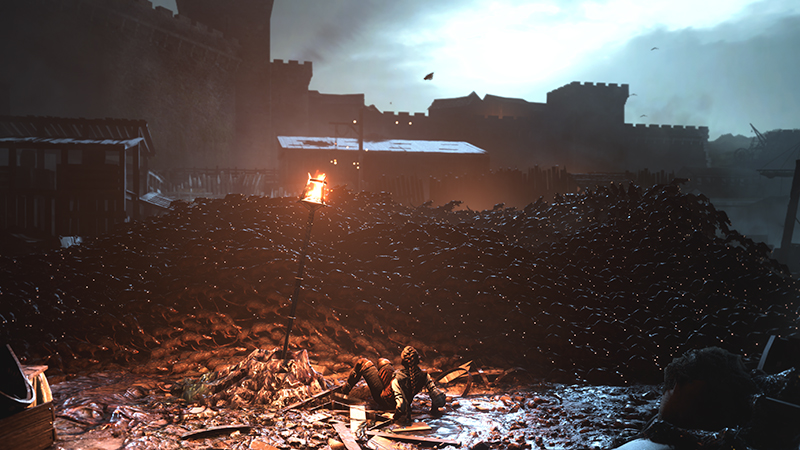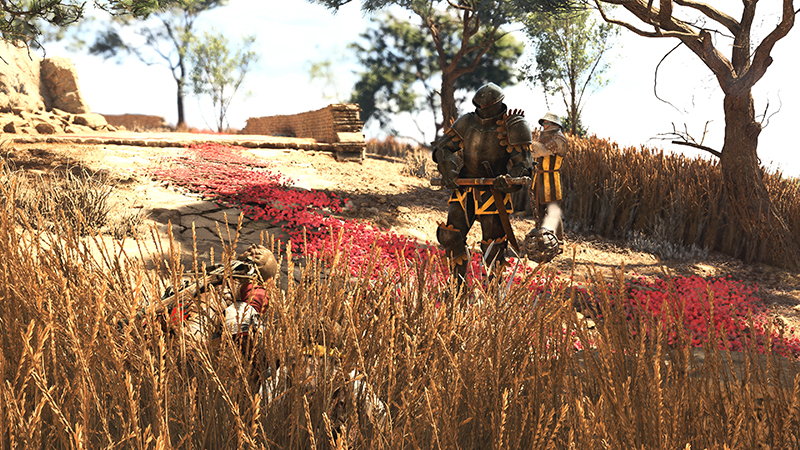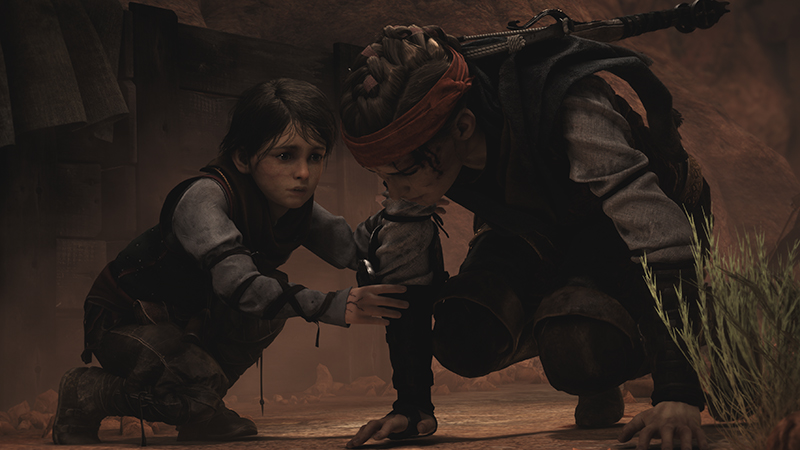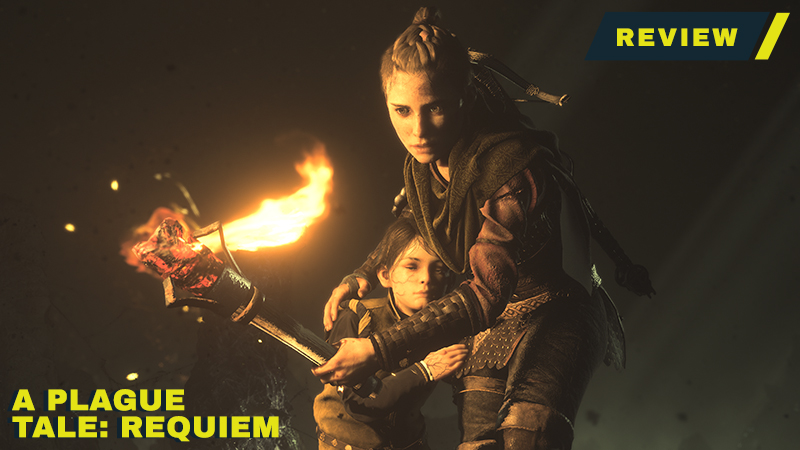Asobo Studio was mostly known for making licensed games until 2019’s A Plague Tale: Innocence. This original narrative-focused adventure was far from a Wall-E-branded collect-a-thon platformer and something more reminiscent of Sony’s first-party output, albeit with a significantly smaller budget. It had some rough spots, but it was an unexpectedly heartwarming tale that excelled because of its strong central relationship. A Plague Tale: Requiem, its sequel, doesn’t have that same element of surprise nor does it iron out the kinks of the original, but it still tells a unique, if uneven, tale with plenty of bizarre and beautiful scenery.

Requiem is able to have such lush scenery because it is one of the few games that has freed itself from the shackles of last-generation hardware. It is a truly gorgeous game, far outmatching Innocence’s modest visuals in every way. Lighting is striking as it bounces around its lush, vibrant forests and darkest catacombs, and is also further augmented by the sheer fidelity of the rock and wood textures that make up the natural and man-made structures. Its grand rat-made structures are even more dazzling since they utilize those same artistic skills but aren’t bound by realism, leading to some horrific and beautiful cavernous areas covered in goo and human remains. Asobo boasts its technical chops by constantly giving players sweeping vistas that show that its quality has not been diminished by its quantity.
Its visuals also aid its set pieces that are, unsurprisingly, filled with tons and tons of rats. Vermin flood in by the hundreds of thousands, creating a stunning spectacle every single time they splash around and destroy the environment like a violent, disease-ridden sea. Their overwhelming numbers create chaos that smaller hordes just could not do and fittingly escalate as the narrative calls for it. It’s as endlessly marvelous to behold as it is disgusting, especially on the PlayStation 5 where the pitter-patter of their feet rumbles throughout the DualSense.
RELATED: Don’t Skip Over A Plague Tale: Innocence Again
But while it’s an impressive sight to behold, it comes at a cost and is just one of many areas where the game fights with itself. Requiem does not always run well and can usually have trouble keeping up with the action. The rat-heavy scenes can slash the frame rate, but it’s not always that predictable. Sometimes the game will slow down slightly when seemingly nothing is happening. Other times it will struggle during cutscenes. There’s not much consistency to its technical inconsistencies and while it is perfectly playable, it calls into question whether or not Asobo should have pushed this game quite this far.

Asobo also augmented the gameplay, but its mechanics haven’t jumped quite as far as its technical specs. Innocence’s combat and stealth were incredibly limited and frequently frustrating. Requiem fares better in these areas since Amicia, the main protagonist, has a crossbow and consumable knives that make her more formidable. She can also hide under certain structures to avoid fighting (for the most part) altogether. There’s at least some way to defend against enemies here, which is a step up.
Even with these extra tools, encounters are still clunky. Most enemies are sluggish, bumbling idiots that unrealistically march toward Amicia after seeing her and will automatically strike her (and awkwardly wait for her to get up in a weird canned scene) if they get too close. This might be a blessing, though, since Amicia is rather slow herself, so faster goons would only be more infuriating. They’re also stupid, too, often just standing in one place — a true sin in a stealth game — or giving up a hunt after mere moments of losing contact. Combined with some restrictive map design and exits that artificially lock during an alert, Requiem ends up being a sequel that is not as big of a mechanical improvement as it deserves to be.
Some of these issues only get worse with the rats. It can be satisfying to lure oblivious guards to their death, but it’s regularly just a pain to deal with the furry critters. Bouncing around light to avoid them is something that wore thin in the last game, especially since failure was so quick and punishing. Asobo has added more ways to move fires around and thankfully doesn’t depend on it for every single level, but it’s rarely ever difficult to figure out and can just get a bit tedious to do so many times.

Requiem takes some bigger swings with its narrative. Amicia and Hugo’s sibling relationship is still at the beating heart of the game and is where its storytelling is the most effective. It’s a darker tale that pushes Amicia to even more extreme lengths and her commitment to her brother makes her a headstrong and admirable protagonist. Hugo is also a loveable little kid and isn’t annoying, meaning players aren’t told to care about them, they just do. A lesser game would have Amicia constantly say she loves her brother, but Requiem, much like its predecessor, shows it instead. Sibling relationships are hardly portrayed well in the medium and A Plague Tale still stands out despite its dearth of competition.
However, much like the rest of the game, the positives come with an almost equal set of negatives. Requiem is a much longer game and that length comes with pacing issues. This elongated approach means that it stretches out too many of its threads while it’s introducing even more of them and cutting others. While the game is busy poking at how Amicia is submitting to her inner demons, it’s also bringing up the self-destructive limits of caring for someone, self-control, learning from past failures, redemption, cults, the history of the Macula, and politics with the antagonistic Count, just to name a few. And despite all of these topics, it somehow still has too much filler dialogue during gameplay, which is another carryover from Innocence.
RELATED: A Plague Tale Is Being Adapted Into a Television Series
It’s a lot to digest and the game doesn’t always spend the time to fully explore each one. A lot of these raise interesting questions, provide worthy backstory, or contain some world-shaking revelations that tie back to the central conflicts well and these glimpses are tantalizing. However, given how erratically many of them are brought up and tied in (or dumped) leads to a narrative that makes some puzzling logical leaps and isn’t as cohesive as it should be. A tighter experience with more honed themes and fewer distractions would have likely been a better fit.
Asobo has made quite a jump from its early days making the Ratatouille tie-in game to this rat-infested sequel. What started out as a humble new series has expanded into something much more ambitious. But while that ambition is admirable and sometimes extraordinary, it’s also the root cause of many of its problems since it lacks focus and seems like Asobo spread itself thin going this much larger. A Plague Tale: Requiem is an improvement in many areas, but those improvements often come with an unfortunate caveat. Those caveats are not as fatal as a bite from one of Requiem‘s plague-ridden rats, but they’re still damaging nonetheless.
SCORE: 7/10
As ComingSoon’s review policy explains, a score of 7 equates to “Good.” A successful piece of entertainment that is worth checking out, but it may not appeal to everyone.










